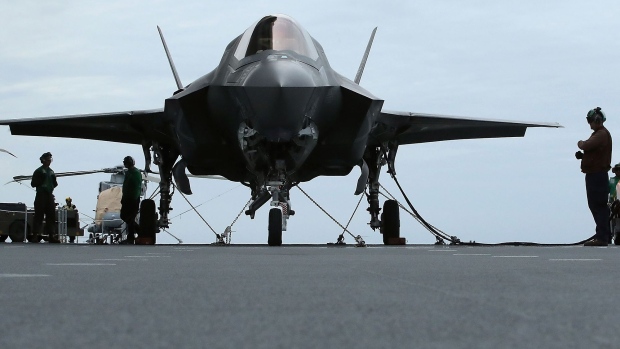Jul 12, 2021
F-35 Closes In on New Timeline for Combat Test Once Set for 2017
, Bloomberg News

(Bloomberg) -- The Pentagon is close to deciding on a new schedule for completing crucial simulated combat testing of the $398 billion F-35 jet against advanced Russian and Chinese air defenses, according to a spokesperson.
The long-delayed 64-sortie exercise in a “Joint Simulation Environment” run by the Navy was last supposed to have been completed in December, though it was originally planned for 2017.
In April, Bloomberg News reported that the Defense Department’s F-35 program office projected the target date as August 2022. The Pentagon declined to comment at the time, saying the schedule was under review.
The F-35 Joint Program Office now “has completed this analysis and is scheduled to deliver the proposed” schedule revision to Pentagon acquisition officials “in the coming weeks,” spokesperson Jessica Maxwell said in a statement.
An independent technical assessment of the simulation exercise by outside experts was completed in May and “those results are informing” the program office’s “proposed revision” to the formal schedule, known as the “Acquisition Program Baseline,” she added.
F-35 Purchases
The testing delay has meant lawmakers are likely to find themselves authorizing the Pentagon to keep buying the next-generation fighters from Lockheed Martin Corp. in fiscal 2022 and 2023 without having a complete picture of the aircraft’s true capabilities. The Pentagon’s current five-year plan calls for requesting 85 F-35s in the 2022 fiscal year that begins Oct. 1, up from 79 this year. That would rise to 94 planes in fiscal 2023.
The simulator testing is meant to determine how the fighter will perform against the most advanced Russian and Chinese aircraft and air defenses. It’s a key benchmark in a program that’s been a work in progress for two decades.
The testing is also needed for the Pentagon to make a decision on allowing the program to enter full-rate production, the most lucrative phase for Lockheed because it will allow the U.S. to enter into long-term multiyear contracts that guarantee quantities and prices.
A House Armed Services subcommittee led by Democratic Representative Donald Norcross of New Jersey will convene Tuesday to review procurement of fixed-wing aircraft, including the F-35. Members are likely to press Lieutenant General Eric Fick, the F-35 program manager, for details on the new schedule.
Congressional Vote
The House Appropriations Committee is scheduled to vote on the 85-aircraft request as part of its approval of the Pentagon’s fiscal 2022 request on Tuesday. Notably, the committee -- for the first time in several years -- didn’t add to the Pentagon’s F-35 request.
Congress is also being asked to approve, without the final testing, additional funds in fiscal 2022 for the F-35’s most important upgrade: Known as “Block 4,” the upgrade has grown in estimated cost from $10.6 billion in 2018 to $14.4 billion now.
In a report released last week summarizing earlier testimony on long-term sustainment costs, the Government Accountability Office disclosed that Pentagon officials told evaluators a full-rate production decision might not occur until 2023.
A decision on full rate production and related evaluations would signal that the Defense Department has completed a range of initial operational testing, addressed critical system deficiencies, and taken action to address key funding issues, Diana Maurer, a GAO director who supervised the report, said in an email.
But for now, “no one knows when the F-35 program will formally enter into full-rate production,” she said.
©2021 Bloomberg L.P.